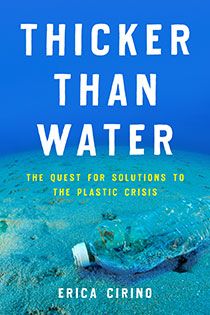
Thicker than Water
Anne Chapman reviews Thicker than Water: the Quest for Solutions to the Plastic Crisis by Erica Cirino (Island Press, 2021).

The Quest for Solutions to the Plastic Crisis
Erica Cirino (Island Press, 2021).
When I was growing up in the 1970s I remember concerns about the increasing use of plastic because it did not degrade. However, when, in the 1980s, I did a masters degree in pollution, the problems all seemed to be caused by things that did degrade, not by things that did not. For example, a key parameter of water pollution was ‘biological oxygen demand’, a measure of the amount of oxygen removed from the water by biological degradation of the organic matter (perhaps from sewage discharges) in the water, that reduction in oxygen having the potential to kill fish. In landfill sites the biological degradation of materials under anaerobic conditions led to the production of landfill gas, composed of methane and carbon dioxide. Plastics, which did not degrade, did not seem to cause any problems. The focus of the professional pollution control and environmental protection community on nineteenth and early twentieth century pollution issues is perhaps one reason why the common sense concern about plastics in the 1970s was ignored. That is, until in the last couple of decades when pictures of turtles eating plastic bags and dead Albatross chicks whose stomachs are full of the plastic debris their parents have mistakenly fed them with, have alerted us to the impacts of plastic on marine life.
In this book Erica Cirino takes us across the Pacific ocean, to the laboratories of Danish scientists, to Lake Erie in the US, to communities in Mississippi fighting the siting of plastic factories in their neighbourhoods, and meets those trying to clear up the plastics littering shores in Hawaii and Thailand. Some of the best storytelling is in the first section – an account of sailing across the North Pacific gyre with Danish plastics researchers, which finishes with them just making it to Honolulu, with no engine or rudder. The gyre is a near windless region of clockwise-spinning water between California and Hawaii in which plastic is accumulating. From the ship they can see bits of bits of plastic floating past, which they pull from sea and they collect samples of sea water to take back to the laboratory to examine for microplastics. In this section we learn some of the basic facts about our production of plastics: 8.3 billion metric tons had been produced by 2015, about 76% of which was only used once or twice before being discarded; 79% of the discarded plastic is in landfills or in the natural environment (p.22); by 2020 the amount of plastic created was two times greater than the mass of all marine and land animals combined (p.36); all that plastic does not degrade to basic molecules that can be incorporated into other things, it just breaks up into smaller and smaller pieces. We also learn how plastic is harming marine life: it is eaten (possibly because microplastic particles in the sea become coated with algae, which is a food for many organisms), filling up the bodies of marine animals without providing any sustenance, plus plastic may bring with it toxic chemicals that were either in the plastic or have become adhered to it once the plastic is in the environment. In the oceans plastic floats on the surface, but then breaks up into smaller and smaller pieces which sink to the sea floor. There could be around 30 times as much plastic on the sea floor as on the surface and that on the surface would disappear within two to three years if we completely stopped plastic from entering the ocean (p.53). Cirino emphasizes the long term damage that plastic is doing to life on the sea floor, but I actually found this bit of information rather hopeful: we could quite quickly get rid of plastic in the water (we ‘just’ have to stop the flow into the sea!) and that would surely improve things massively for marine life. Over time that on the sea floor would get buried as sediment is deposited on top if it: in a few million years there will be a geological stratum containing microplastics.
After the oceans Cirino works her way upstream, first looking at the impacts of plastic on freshwater ecosystems through a visit to researchers studying the increasing quantities of microplastics in the sediment of Lake Erie. She describes experiments with daphnia, a small freshwater crustacean, which found that it ate microbeads (used in cleansing products) in preference to algae. Other scientists are looking in detail at what chemicals the daphnia eating microbeads in Lake Erie may be taking in with them: Cirino describes the painstaking process of examination of individual microbeads so any flatter surfaces could be scanned to determine what chemicals are present. Polyfluoroalkyl substances (PFAS) were found on microbeads from lake sediments, but not on beads taken directly from cleansing products (p.85). PFAS are very persistent synthetic chemicals used in a vast array of products and now thought to have a range of impacts on health.
Cirino then travels to Denmark and meets a mannequin designed to breath like a human, used to measure how much microplastic we may be taking in from the air we breath. From leaving the ‘breathing’ mannequin in student apartments the researchers estimate that we might be breathing in around eleven pieces of microplastic an hour when indoors, the most common type being polyester, from the furniture, carpets and clothing we have in our homes (p.95). Outdoors we are also exposed to microplastics, in urban areas the fragments shed from synthetic tyres being particularly common. A chemical from these tyres, 6PPD-quinone, is thought to be a major factor in the die-off of coho salmon in the Pacific North West of the USA (p.96). We not only breath in microplastics but ingest it in the food we eat. Cirino suggests that the use of low-density polyethelene sheets in horticulture introduce microplastics to the soil, which is then incorporated in plant roots. From the amount of microplastic in human diets it’s been estimated that we consume thirty-nine thousand to fifty-two thousand pieces of microplastic each year, with an additional ninety thousand if we regularly drink bottled water (p.98). As well as toxic chemicals adhering to their surface, those bits of plastic may be colonized by harmful viruses and bacteria (p.99). Scientists are now starting to look for microplastics in human tissues: a team in Italy has found them in samples of human placenta, collected after the birth of the babies (p.101).
What harm is caused to us by our burden of microplastics is of course very difficult to say with certainty: it is in the nature of our exposure to many different synthetic chemicals that proof of the harm caused by any particular one is difficult to obtain. What is clearer is the harm caused by the manufacture of plastics. Cirino visits a predominantly African American community in Louisiana fighting plans for a new plastic factory. Their area already has numerous chemical plants and oil refineries, the pollution from which results in a significantly increased incidence of cancer.
In the final sections Cirino examines the pros and cons of possible alternatives to plastic, such as bioplastics made from plant matter or bacteria, clothing made from algae and packaging material made from hemp and fungi mycelium. This section betrays some scientific illiteracy on the part of Cirino, for example when she says that composting releases ‘a significantly smaller amount of carbon dioxide as a byproduct’ compared to landfilling. It is not the amount of carbon dioxide that is the issue: it is part of the contemporary carbon cycle, replacing that which was taken out of the air by the plant which the composting organic matter came from, so does not increase greenhouse gases. When landfilling waste it is the methane produced under anaerobic conditions that is the problem, methane being a much more potent greenhouse gas than carbon dioxide. I found it strange that this section does not mention the obvious alternatives to much plastic, which is to go back to using the natural materials we used before: for example, wool instead of acrylic and polyester. My suspicion is that Cirino does not want to condone animal agriculture, but wool is currently not worth the cost of shearing and better use of the whole animal – the bones as well as the skin (to make leather) – could replace plastic, without increasing the number of animals kept.
Finally there are accounts of moves to legislate against single-use plastic and increase recycling: bans on plastic bags in Africa; an account of battles to get legislation on plastic passed in Hawaii, and Copenhagen’s recycling of plastic food trays. Cirino reveals that the businesses that stand to lose employ the tactic seen in other fields, of blaming the individual; in this instance for ‘littering behaviour’. One thing though that she does not mention, which to me seems to be the real solution, is to turn off the tap of plastic by stopping the extraction of fossil fuels. From a cheap, throwaway material plastic needs to become an expensive, scarce resource that we just use for those uses in which it can’t be replaced by alternatives. Only then, I think, will we stop throwing it away, recycling will become economically attractive, and we will be forced to pull plastic out of the sea and mine it from landfills.


